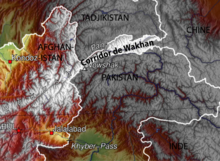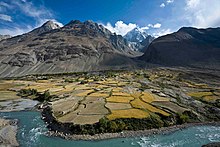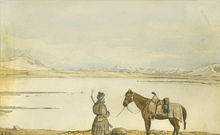Wakhan Corridor
| Wakhan Corridor | |||||||||||||
|---|---|---|---|---|---|---|---|---|---|---|---|---|---|
 Wakhan Corridor | |||||||||||||
 | |||||||||||||
| Chinese name | |||||||||||||
| Simplified Chinese | 瓦罕走廊 | ||||||||||||
| Traditional Chinese | 瓦罕走廊 | ||||||||||||
| Literal meaning | Wakhan Corridor | ||||||||||||
| |||||||||||||
| Alternative Chinese name | |||||||||||||
| Simplified Chinese | 阿富汗走廊 | ||||||||||||
| Traditional Chinese | 阿富汗走廊 | ||||||||||||
| Literal meaning | Afghan Corridor | ||||||||||||
| |||||||||||||
| Second alternative Chinese name | |||||||||||||
| Simplified Chinese | 瓦罕帕米尔 | ||||||||||||
| Traditional Chinese | 瓦罕帕米爾 | ||||||||||||
| Literal meaning | Wakhan Pamir | ||||||||||||
| |||||||||||||
| Pashto name | |||||||||||||
| Pashto | دهلېز واخان | ||||||||||||
The Wakhan Corridor (Dari: دالان واخان, romanized: Dâlân-e wâxân; Pashto: واخان دهلېز, romanized: Vâxân dahléz) is a narrow strip of territory in the Badakhshan province of Afghanistan. This corridor stretches eastward, connecting Afghanistan to Xinjiang, China. It also separates the Gorno-Badakhshan Autonomous Region of Tajikistan in the north from the Khyber Pakhtunkhwa and Gilgit-Baltistan regions in Pakistan in the south, the latter of which is also part of the disputed region of Kashmir.[1][2][3][4][5][a] This high mountain valley, which rises to a maximum altitude of 4,923 m (16,152 ft), serves as the source of both the Panj and Pamir rivers, which converge to form the larger Amu Darya River. For countless centuries, a vital trade route has traversed this valley, facilitating the movement of travelers to and from East, South, and Central Asia.[6]
The corridor was formed after an 1893 agreement between Mortimer Durand of the British Raj and Emir Abdur Rahman Khan of Afghanistan, creating the Durand Line.[7] It was last conquered by the Durrani Empire in 1763.[8] This narrow strip acted as a buffer zone between the Russian Empire and the British Empire (the regions of Russian Turkestan, now in Tajikistan and the northern part of British Raj, now in Pakistan). Its eastern end bordered China's Xinjiang region, then claimed by the Qing dynasty.
The corridor is in the Wakhan District of Afghanistan's Badakhshan province. As of 2020, it had 17,167 residents.[9] The northern part of the Wakhan, populated by the Wakhi and Pamiri people, is also referred to as the Pamir. The closest major airport for the residents to use is Fayzabad Airport in the city of Fayzabad to the west, which can be reached by a road network.
Geography
[edit]

At its western entrance, near the Afghan town of Ishkashim, the corridor is 18 km (11 mi) wide.[4] The western third of the corridor varies in width (13–30 km (8–19 mi)) and widens to 65 km (40 mi) in the central Wakhan.[4] At its eastern end, the corridor forks into two prongs that wrap around a salient of Chinese territory, forming the 92 km (57 mi) boundary between the two countries.[4] The Wakhjir Pass, which is the easternmost point on the southeastern prong, is about 300 km (190 mi) from Ishkashim.[4] The easternmost point of the northeastern prong is a nameless wilderness about 350 km (220 mi) from Ishkashim.[4] On the Chinese side of the border is the Tashkurgan Tajik Autonomous County of Xinjiang Uyghur Autonomous Region.
The northern border of the corridor is formed by the Pamir River and Lake Zorkul in the west and the high peaks of the Pamir Mountains in the east. To the north is Tajikistan's Gorno-Badakhshan Autonomous Region. To the south, the corridor is bounded by the high mountains of the Hindu Kush and Karakoram. Along the southern flank of the corridor, there are two mountain passes that connect the corridor to its neighbours. The Broghol pass offers access to the Khyber Pakhtunkhwa region of Pakistan, while the Irshad Pass connects the corridor to Gilgit-Baltistan. The Dilisang Pass, which also connects to Gilgit-Baltistan, is disused.[11] The easternmost pass, as indicated above, is the Wakhjir Pass, which connects to China and is the only border connection between that country and Afghanistan.
The corridor is higher in the east than in the west; (the Wakhjir Pass is 4,923 m (16,152 ft) in elevation) and descends to about 3,037 m (9,964 ft) at Ishkashim.[12] The Wakhjir River emerges from an ice cave on the Afghan side of the Wakhjir Pass and flows west, joining the Bozai Darya near the village of Bozai Gumbaz to form the Wakhan River. The Wakhan River then joins the Pamir River near Kala-i-Panj to form the Panj River, which then flows out of the Wakhan Corridor at Ishkashim.
The Chinese consider Chalachigu Valley, the valley east of Wakhjir Pass on the Chinese side connecting Taghdumbash Pamir, to be part of the Wakhan Corridor. The high mountain valley is about 100 km (60 mi) long. This valley, through which the Tashkurgan River flows, is generally about 3–5 km (2–3 mi) wide and less than 1 km (0.6 mi) at its narrowest point.[13] This entire valley on the Chinese side is closed to visitors; however, local residents and herders from the area are permitted access.[14]
History
[edit]Although the terrain is extremely rugged, the Corridor was historically used as a trading route between Kabul and Kashgar.[15][16] It appears that Alexander the Great, Song Yun, Huisheng, Xuanzang, Marco Polo, and many others came this way.[17] The Portuguese Jesuit priest Bento de Goes crossed from the Wakhan to China between 1602 and 1606. The area was visited under the watchful eyes of the Russians by Thomas Edward Gordon in 1874,[18] and in 1891 by Francis Younghusband,[19] followed by Lord Curzon in 1894.[20] While visiting Wakhan in May 1906, Aurel Stein reported that 100 pony loads of goods crossed annually to China.[21]
Early travellers used one of three routes:
- A northern route led up the valley of the Pamir River to Zorkul Lake, then east through the mountains to the valley of the Bartang River, then across the Sarikol Range to China.
- A southern route led up the valley of the Wakhan River to the Wakhjir Pass to China. This pass is closed for at least five months a year and is only open irregularly for the remainder.[22]
- A central route branched off the southern route through the Little Pamir to the Murghab River valley.
From a non-Afghan point of view, the corridor is in part a political creation from The Great Game between British India and Russian Empire. In the north, an agreement between the empires in 1873 effectively split the historic region of Wakhan by making the Panj and Pamir Rivers the border between Afghanistan and the then-Russian Empire.[4] In the south, the Durand Line Agreement of 1893 marked the boundary between British India and Afghanistan. This left a narrow strip of land ruled by Afghanistan as a buffer between the two empires, which became known as the Wakhan Corridor in the 20th century.[23]
The corridor has been closed to regular traffic for over a century[12] and there is no modern road. There is a rough road from Ishkashim to Sarhad-e Broghil[24] built in the 1960s,[25] but only rough paths beyond. These paths run some 100 km (60 mi) from the road end to the Chinese border at Wakhjir Pass, and further to the far end of the Little Pamir.
Jacob Townsend has speculated on the possibility of drug smuggling from Afghanistan to China via the Wakhan Corridor and Wakhjir Pass, but concluded that due to the difficulties of travel and border crossings, it would be minor compared to that conducted via Tajikistan's Gorno-Badakhshan Autonomous Province or through Pakistan, both having much more accessible routes into China.[26]
The remoteness of the region has meant that, despite the long-running wars of Afghanistan since the late 1970s, the region has remained virtually untouched by conflict, and many locals, mostly composed of ethnic Pamir and Kyrgyz, are not aware of the wars in the country.[27]
The Islamic Republic of Afghanistan asked the People's Republic of China on several occasions to open the border in the Wakhan Corridor for economic reasons or as an alternative supply route for fighting the Taliban insurgency. The Chinese resisted, largely due to unrest in its far western province of Xinjiang, which borders the corridor.[28][29] In December 2009[update], it was reported that the United States had asked China to open the corridor.[30]
In July, 2021, the area came under the Taliban control for the first time during the group's summer offensive.[31] It was reported that hundreds of ethnic Kyrgyz nomads along with their livestock attempted to flee north into Tajikistan.[32] It is patrolled by forces of the Islamic Emirate of Afghanistan, which took over responsibility from the previous NATO-trained Afghan National Security Forces.[33][34]
As of June 2023, there had been discussions between foreign ministers of China and Afghanistan concerning the opening of the strategically significant corridor to enhance the trade ties between Beijing and Kabul. Afghanistan's Foreign Minister Amir Khan Muttaqi and Chinese Foreign Minister Wang Yi both met on the sidelines in Tibet during the third Trans-Himalaya Forum for International Cooperation, to discuss the possibilities of improving trade ties.[35] Though the Taliban government finished a 50-km road through the corridor to reach the Chinese border, Beijing seems disinclined to open the border, due to security concerns.[36][37]
In 2024 an independent analysis conducted at the University of Texas at Austin which relied on open source intelligence suggested the corridor consists of, "primarily dirt roads and footpaths that abruptly end before reaching the border."[38]
See also
[edit]References
[edit]- Citations
- ^ Bruce Elleman; Stephen Kotkin; Clive Schofield (18 May 2015). Beijing's Power and China's Borders: Twenty Neighbors in Asia. M.E. Sharpe. pp. 13–. ISBN 978-0-7656-2766-7.
The Sino-Afghan border was delimited in a secret treaty signed during November 1963. The corridor shares a border with Pakistan to its south and Tajikistan to its north.
- ^ Pervaiz I Cheema; Manuel Riemer (22 August 1990). Pakistan's Defence Policy 1947-58. Palgrave Macmillan UK. pp. 46–. ISBN 978-1-349-20942-2.
In addition, the Soviet Union is separated from Pakistani territory by a small strip commonly known as the Wakhan corridor. Theoretically the Soviet Union does not have a common border with Pakistan but in view of their close linkage with Afghanistan and the shortness of Wakhan's breadth make it an immediate neighbour for all practical purposes.
- ^ Yasmeen Niaz Mohiuddin (2007). Pakistan: A Global Studies Handbook. ABC-CLIO. pp. 18–. ISBN 978-1-85109-801-9.
The Chitral and Kalash valleys of the Hindu Kush Mountains are located north of the Swat Valley in the Chitral district of the North-West Frontier Province and are bordered by Afghanistan on the north, south, and west. The Wakhan Corridor separates Pakistan from Tajikistan. The corridor, wedged between the Pamir Mountains to the north and the Karakoram range to the south, is about 350 km (220 mi) long and 13–65 kilometres (8–40 mi) wide.
- ^ a b c d e f g International Boundary Study of the Afghanistan–USSR Boundary (1983) by the US Bureau of Intelligence and Research Pg. 7. Archived on 2011-06-07
- ^ Ashraf, Fahmida (1986). "The Strategic Wakhan". Strategic Studies. 9 (2): 48–67. ISSN 1029-0990. JSTOR 45182417. Archived from the original on 5 April 2023. Retrieved 4 April 2023.
- ^ "Wakhan Corridor travel guide". Caravanistan. Retrieved 29 October 2018.
- ^ Nystrop, Richard F. And Donald M. Seekins, eds. Afghanistan a Country Study. Washington: Library of Congress, 1986, p. 38.
- ^ "'Do You Not Bow before Heaven?': The First Qing- Durrānī Encounter, the Tributary Non-relationship, and Disorder on a Shared Frontier". Brill Publishers. 7 June 2023. Retrieved 3 January 2025.
- ^ https://web.archive.org/web/20210624204559/https://www.nsia.gov.af:8080/wp-content/uploads/2021/06/Estimated-Population-of-Afghanistan1-1400.pdf (p. 87)
- ^ "Lake Victoria, Great Pamir, May 2nd, 1874 - Lake Victoria, Great Pamir, May 2nd, 1874". Sphinxfineart.com. Retrieved 11 December 2021.
- ^ The pass was crossed by a couple in 1950 and by a couple in 2004. See J.Mock and K. O'Neil: Expedition Report Archived 8 January 2011 at the Wayback Machine
- ^ a b FACTBOX-Key facts about the Wakhan Corridor Archived 25 January 2022 at the Wayback Machine. Reuters. 12 June 2009
- ^ "新疆边境行:记者抵达瓦罕走廊中方最西端(图)_新闻中心_新浪网" [Xinjiang Border Tour: Reporter arrived at the Chinese westernmost point of Wakhan Corridor]. news.sina.com.cn (in Chinese). Global Times. 7 July 2011. Archived from the original on 18 August 2016. Retrieved 5 February 2017.
- ^ Urwin, Simon (3 July 2021). "A new road to an inaccessible land". BBC Travel. Retrieved 14 November 2021.
- ^ Beveridge, Annette Susannah (7 January 2014). The Bābur-nāma in English, Memoirs of Bābur. Project Gutenberg. p. 202.
- ^ Stein, Mark Aurel (1907). "Ancient Khotan". Nature. 76 (1981): 619–620. Bibcode:1907Natur..76..619H. doi:10.1038/076619a0. S2CID 3999325.
- ^ The Travels of Marco Polo, Book 1, Chapter 32
- ^ Keay, J. (1983). When Men and Mountains Meet. pp. 256–7. ISBN 0-7126-0196-1.
- ^ Younghusband, F. (1896, republished 2000) "The Heart of a Continent" ISBN 978-1-4212-6551-3
- ^ "Geographical Journal" (July to September 1896)
- ^ Shahrani, M. Nazif (1979 and 2002) p.37
- ^ Townsend, Jacob (2005). "4. Routes into Xinjiang". China and Afghan Opiates: Assessing the Risk (PDF). Archived from the original (PDF) on 17 July 2012.
- ^ Jacobs, Frank (5 December 2011). "A Few Salient Points". The New York Times. Archived from the original on 2 July 2018. Retrieved 19 May 2017.
- ^ "2004 Mock & O'Neil Wakhan Expedition Report". Mockandoneil.com. Archived from the original on 9 May 2013. Retrieved 11 December 2021.
- ^ "United Nations Environment Programme (2003) Wakhan Mission Report" (PDF). Archived (PDF) from the original on 16 August 2019. Retrieved 26 July 2010.
- ^ "China and Afghan Opiates: Assessing the Risk" (Chapter 4). June 2005
- ^ "Wakhan Corridor: The Afghanistan Province Untouched by Government, War or Terror". 10 February 2018.
- ^ Afghanistan tells China to open Wakhan corridor route. The Hindu. 11 June 2009 Archived 8 January 2011 at the Wayback Machine
- ^ China mulls Afghan border request Archived 10 September 2017 at the Wayback Machine. BBC News Online. 12 June 2009
- ^ "Southasiaanalysis.org". Southasiaanalysis.org. Archived from the original on 13 June 2010. Retrieved 11 December 2021.
- ^ Juanola, Marta Pascual (23 July 2021). "The Taliban conquest of a thin strip of land could change Afghanistan". The Sydney Morning Herald. Archived from the original on 27 August 2021. Retrieved 11 December 2021.
- ^ Kramer, Andrew E. (29 July 2021). "These Herders Lived in Peaceful Isolation. Now, War Has Found Them". The New York Times. Archived from the original on 29 July 2021. Retrieved 11 December 2021.
- ^ "Cabinet orders military deployment, services in Wakhan valley". Pajhwok Afghan News. 20 November 2022. Retrieved 21 December 2022.
- ^ "Wakhan: The Corridor of Complication between Taliban, Pakistan and China". India Today. 1 August 2022. Retrieved 21 December 2022.
- ^ "Chinese, Afghan foreign ministers discuss opening of strategic Wakhan Corridor". www.aa.com.tr. Retrieved 24 October 2023.
- ^ "Construction of Wakhan road between Afghanistan-China to be completed before winter: MRRD". Ariana News. 24 August 2024. Retrieved 4 January 2025.
- ^ "China fails to strike connectivity goal with Taliban amid security threats in Xinjiang: Report". 27 January 2024.
- ^ https://www.tearline.mil/public_page/chinese-economic-cooperation-with-the-taliban
- ^ India also claims to have a border with Afghanistan's Wakhan Corridor in its northwest due to its claim on Kashmir. However, this is disputed and the region bordering Afghanistan is administered by Pakistan as part of Gilgit-Baltistan (see Borders of India#Land borders of India.)
- Sources
- Shahrani, M. Nazif (2002). The Kirghiz and Wakhi of Afghanistan: Adaptation to Closed Frontiers and War (2nd ed.). University of Washington Press. ISBN 978-0-295-98262-5.
External links
[edit]- Pamir Skyroad Towards Afghan Wakhan Corridor on YouTube
- "In Photos: Wakhan Corridor, Afghanistan". Nicole L. Smoot. Retrieved 21 December 2022.
- Food and non-food items were given to the residents of Wakhan district of Badakhshan province on YouTube (Radio Television Afghanistan (RTA Pashto))
- The visit of the head of Badakhshan culture information to Wakhan on YouTube (RTA Dari)
- Prisoners of the Afghan Pamir on YouTube
- Afghanistan: In the Wakhan Corridor - The roads of the impossible on YouTube
- Stranded on the Roof of the World 2013 National Geographic Magazine article
- A Short Walk in the Wakhan Corridor, article by Mark Jenkins in the November 2005 issue of Outside magazine
- Wakhan & the Afghan Pamir - In the footsteps of Marco Polo - Brochure of the region by Aga Khan Foundation

